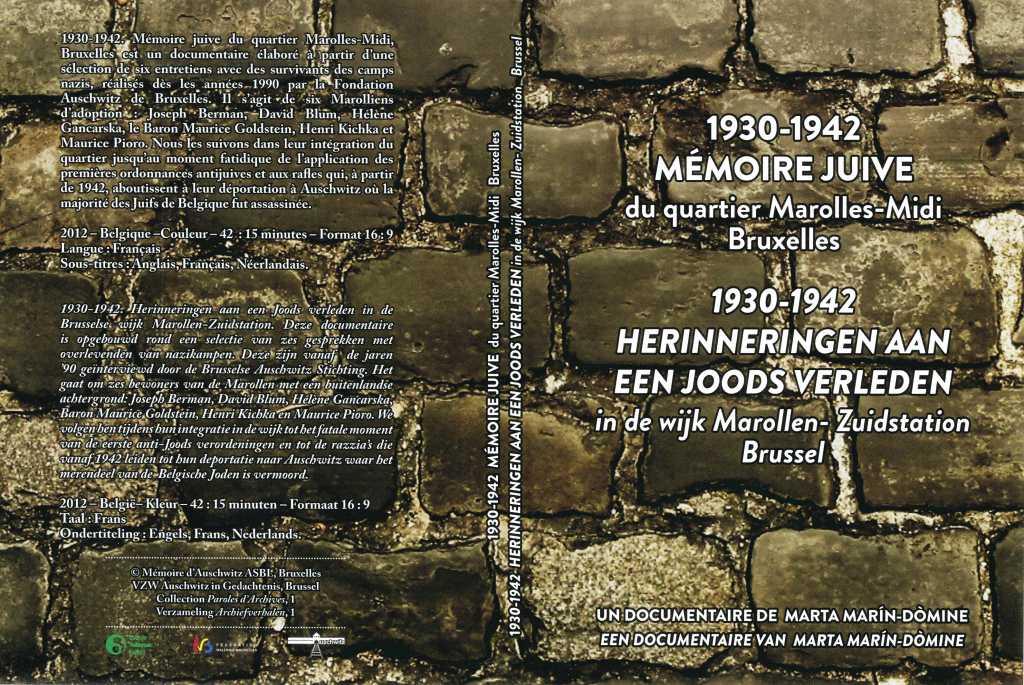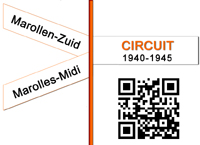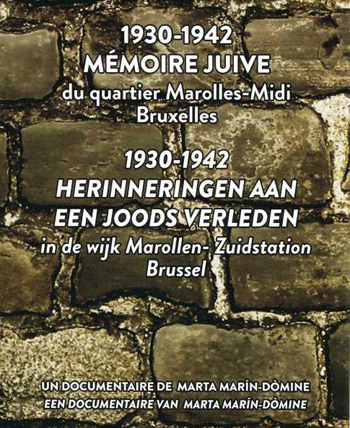‘Marolles-Midi’ project
Projects Focusing on the “Marolles-Midi” District of Brussels
Reminiscences of the “Marolles-Midi” district
The Auschwitz Foundation’s premises are located in the heart of what from the 1920s until the Second World War was the main Jewish quarter of Brussels. The Jewish community had arrived in successive waves and had settled around the South Station, notably in the Marolles district, but today its presence seems to have been almost completely forgotten. As a result, it is difficult to discover its traces. If they exist at all, they are essentially to be found in the memories of those concerned, or among historians. What remains on the ground? Would it be possible to “reconstitute” Jewish life in the quarter? It is worth recalling why so many of these Jews had fled the poverty and violence in their countries of origin, and, from 1933 onwards, from the Third Reich and the countries it invaded? At that time, victims of persecution saw Belgium, which was relatively welcoming, tolerant, and rich, as a desirable place of refuge. We will then go on to examine in more detail why these people chose to make their homes in Belgium, and more particularly in the Marolles. Another angle of approach will be describing the difficulties inherent in any forced migration, in making a new home, and the procedures for becoming an official resident in Belgium.
We would like to describe this period in the district’s history, notably its socio-economic fabric, in such a way as to bring it to life as fully as possible. Were there internal or external assistance networks for the immigrants, and where did any support come from? How did the district’s cultural life develop? What about relationships with the locals and with other immigrant communities? The experiences of these new arrivals during that period are likely to be similar in some ways to certain problems which are still current in Belgium today, but for the Jews of Belgium in the last century the situation changed dramatically with the German occupation. As in every country which they occupied or which collaborated with them, the Germans flouted the legislation that protected Belgium’s inhabitants, and established procedures for wiping out the Jewish community by registering, marking out, isolating and then deporting it. How did they proceed in the Marolles to achieve their goals (census, creation of the Association des Juifs en Belgique [the Association of Jews in Belgium*], obligation to wear the yellow star, ban on working, owning a business, etc)? What anti-Jewish measures were adopted? How did members of the community and their neighbours react? Did some Jews succeed in protecting themselves or escaping? What were their possibilities of resistance? And who helped those in hiding? Of course, the round-ups and the deportations to Auschwitz spread terror and made the situation of those left behind still more precarious. The answers to these questions, notably in the form of an exhibition, will enable us to retrace the way in which the Jewish population of the Marolles lived before the deportations. To illustrate that way of life, we will seek out statements and documents left behind by witnesses, as well as anecdotes revealing the human side of these historical events.
* NB: the Nazis wanted an association of “Jews in Belgium” rather than of “Belgian Jews” because some 50% of the Jews resident in Belgium did not have Belgian nationality.
Objectives
By resurrecting the “Jewish Marolles” as a centre of Jewish immigration, we will be able to highlight the district’s extremely rich social fabric. Thus we will be able to link the past and present history of the Marolles as a district which has always been a haven of refuge, and still is today. This approach will also highlight the fact that immigration remains a major problem in contemporary society.
To achieve our aims, we welcome contributions from individuals and associations who would like to take part in one of the proposed projects listed below, or who could provide us with anecdotes or documents for our records.
“Marolles-Midi” – proposed projects
- History and memory – a guided walk through the district
Opening of the new website The Jewish and Resistance Memory of the “Marolles-Midi” District of Brussels
Actually you can view the following pages:
- the working class Union at the “Café des Tramwaymen”: rue du Poinçon, 18;
- the “Association des Juifs en Belgique” [Association of Jews in Belgium]: boulevard du Midi, 56;
- the rescue operation conducted by Paul Halter at the “Couvent du Très Saint-Sauveur” [Convent of the Holy Saviour]: avenue Clémenceau, 70;
- the arrest of resistant Louise de Landsheere at the graphic studio Nova: rue des Tanneurs, 52;
- the “Centrale antijuive pour la Flandre et la Wallonie” [Anti-Jew centre for Flandres and Wallonia]: rue Philippe de Champagne, 52;
- the association “Entr’Aide des Travailleuses” (Social support to the woman workers), called now “Centre d’Action Sociale de l’Entr’Aide des Marolles” [The centre of social action for mutual support at the Marolles]: rue des Tanneurs, 167-169;
- the “Comité d’Assistance aux Réfugiés juifs” [Assistance Committee for Jewish Refugees]: rue Roger Van der Weyden, 25-27;
- sham “funeral” for Adolf Hitler, June 10, 1945: left from rue de la Prévoyance, 44;
- the monument against nazism and racism: rue de Lenglentier, 1a;
- the “Faux Soir”: rue de Ruysbroeck, 35;
- the printing plate of the “Faux Soir”: rue Van Lint, 14 (Anderlecht);
- the air-raid shelter under the Place du Jeu de Balle;
- Sophie Poznanska and the Red Orchestra: rue Jean Volders, 32 (Saint-Gilles).
The website, called to be enhanced soon by contributions of witnesses, should lead to a more complete understanding of the realities of the neighbourhood from the early years of the arrival of the Jewish refugees until their tragic epilogue.
- Audiovisual recording of testimony
A campaign to record testimony by witnesses and hidden Jewish children who lived in the “Marolles-Midi” district.
- Audiovisual archives
Testimony by camp survivors and hidden Jewish children from the district. Creation of a “Marolles-Midi” DVD based on a montage of extracts from the Auschwitz Foundation’s audiovisual archives.
1930-1942. Mémoire juive du quartier Marolles-Midi, Bruxelles [1930-1942: Jewish Memories of the Marolles-Midi District of Brussels] is a French-language documentary based on a selection of interviews that the Auschwitz Foundation recorded during the 1990s with six survivors of the Nazi camps.
These six adopted “Marollians” are Joseph Berman, David Blum, Hélène Gangarska, Baron Maurice Goldstein, Henri Kichka and Maurice Pioro.
We follow them as they settle into the district. They they recount the fateful period from the entry into force of the first anti-Jewish measures in Belgium to the roundups which, beginning in 1942, led to their deportation to Auschwitz, where almost half of Belgium’s Jews were murdered.
This DVD, directed by Marta Marín-Dòmine and produced under the aegis of Remembrance of Auschwitz, is on sale from June 2012 at the price of €12.50.
It is in French, with Dutch and English subtitles.
15/11/2012 – Article in Dutch by Jean-Marie Binst, “Stichting Auschwitz brengt dvd met getuigenissen: Leven en overleven in de Marollen” published in Brussel Deze Week
19/11/2012 – Article in French by Christian Laporte, “La mémoire juive des Marolles” published in La Libre Belgique
- “Amateur film” archive
Setting up an “amateur film” archive on the quarter. The aim is to collect, digitize, archive and present films, essentially made by individuals, which relate to events that took place in the “Marolles-Midi” district during the first half of the twentieth century (popular festivals, folklore, family life, the local environment, inaugurations, shows, life stories, immigration, etc.). We invite anyone who possesses such films and wishes to preserve them to deposit them in our archives or simply make them temporarily available to us.
Contact: Daniel Weyssow, project manager.
 Visit our external website :
Visit our external website :
« Circuit Marolles-Midi. Histoire et mémoire d'un quartier bruxellois »
www.marolles-jewishmemories.net
DVD Trailer (in French)
Photos of the presentation day
Contact
Auschwitz Foundation – Remembrance of Auschwitz
Rue aux Laines 17 box 50 – B-1000 Brussels +32 (0)2 512 79 98
+32 (0)2 512 79 98 info@auschwitz.be
info@auschwitz.be
BCE/KBO Auschwitz Foundation: 0876787354
BCE/KBO Remembrance of Auschwitz: 0420667323
Office open from Monday to Friday 9:30am to 4:30pm.
Visit only by appointment.
![]()
![]()
![]()
![]()
![]()
Become a member
To become a member of Remembrance of Auschwitz ASBL, please contact us and transfer the sum of €50.00 to our account IBAN: BE55 3100 7805 1744 – BIC: BBRUBEBB with the communication: ‘Membership fee 2025’. The membership includes two issues of 2025 of our scientific journal.
DONATIONS
Donations of €40.00 or more (in one or more instalments) qualify for tax exemption for Belgian taxpayers.
In communication, please specify that it is a ‘Donation’ and mention your National Number which is required since 2024 to benefit from the tax exemption.
Subscribe
Error : Please select some lists in your AcyMailing module configuration for the field "Automatically subscribe to" and make sure the selected lists are enabled


